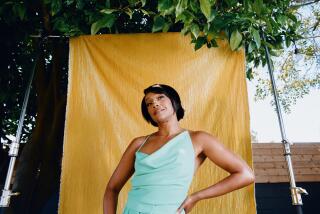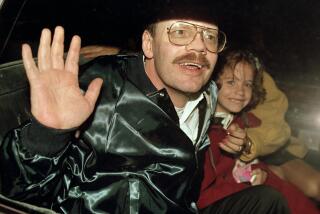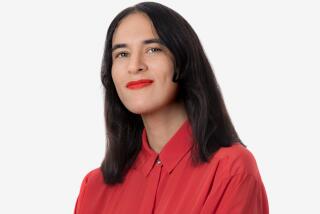Anthony Shadid’s cousin takes a shot at NYT -- and journalism in general
- Share via
Those who were there said the crowd gasped.
Ed Shadid, the cousin of late New York Times reporter Anthony Shadid, was speaking at a banquet for the American-Arab Anti-Discrimination Committee on Saturday night in Washington, D.C. He had been offering advice on how people could support Anthony’s causes when he dropped a bombshell that instantly hit Twitter and later made headlines at Politico and Gawker.
“It’s not the rosy picture, I’m trying to say, that was portrayed,” Ed Shadid said of the New York Times’ depiction of his cousin’s decision to go into Syria. There, Anthony Shadid collapsed and died of an asthma attack, apparently related to a horse allergy, while reporting on the uprising against President Bashar Assad’s regime.
“The phone call the night before he left, there was screaming and slamming down the phone in discussions with his editors. … It was at that time that he called his wife and gave his last, haunting directive: That if anything happens to me, I want the world to know the New York Times killed me.”
That remark immediately grabbed the attention of those familiar with Shadid’s courageous reputation, which was defined by a persistence in returning to crisis again and again. A reporter for the New York Times, the Washington Post and the Boston Globe, Shadid built a Pulitzer-winning career on the back of dangerous assignments in such global hotspots as Iraq, Libya and the West Bank.
Shadid took a bullet in the back -- he believed from an Israeli soldier -- in the West Bank in 2002, and he was kidnapped and beaten with three other New York Times journalists in Libya during last year’s civil war. But he continued his work with the New York Times.
Thus far, Anthony Shadid’s “final directive” to say the New York Times was responsible for his death has not been confirmed by anyone other than Ed Shadid.
“Anthony’s death was a tragedy, and we appreciate the enduring grief that his family feels,” a New York Times spokeswoman said in a statement. “With respect, we disagree with Ed Shadid’s version of the facts. The Times does not pressure reporters to go into combat zones. Anthony was an experienced, motivated correspondent. He decided whether, how and when to enter Syria, and was told by his editors, including on the day of the trip, that he should not make the trip if he felt it was not advisable for any reason.”
In an interview with the Los Angeles Times, Ed Shadid, a surgeon from Oklahoma, said he heard about his cousin’s argument with an editor when he arrived in Lebanon a few days after Anthony Shadid’s death.
“Some things have taken a while to piece together,” Ed Shadid said. “The angry phone call was [heard by] Anthony’s sister-in-law, who came home around midnight. As she came into the home, Anthony was yelling with his editors and ended up slamming down the phone and said, ‘this is horse [expletive].’ ”
The argument had to do with equipment for the trip and a lack of transportation, Ed Shadid said. “His editor said something along the lines of, ‘Well, Anthony, you’re going to get some exercise on this assignment,’ and that was the comment that set him off -- well, not just because of that comment, but that comment was particularly offensive.”
Confirmation from the family has been noticeably absent.
Anthony Shadid’s sister-in-law, whose name Ed Shadid said he didn’t know, did not respond to an email from the Los Angeles Times.
Damon Shadid, Anthony’s brother and a Seattle attorney, told the Los Angeles Times, “I am sorry, I am not going to comment on this story in any way.”
Shadid’s wife, Nada Bakri — who has also reported for the New York Times — did not return a call seeking comment, and took to Twitter to say that she didn’t plan to.
“I do not approve of and will not be a part of any public discussion of Anthony’s passing,” she tweeted. “It does nothing but sadden Anthony’s children to have to endure repeated public discussion of the circumstances of their father’s death.”
In an interview with CNN’s Erin Burnett shortly after her husband’s death, Bakri became briefly emotional when she said that his death had made her “a little mad at journalism.”
The clearest picture on what happened to Anthony Shadid on his final days comes from Tyler Hicks, the New York Times staff photographer who planned the trip with Shadid and who was with Shadid throughout the Syria visit until the reporter died.
In a phone interview from Kenya, Hicks told the Los Angeles Times that Shadid was pressuring his editors to make the trip happen, not the other way around, during an eight-week preparation period.
“Anthony was very passionate about what was happening to the civilian population in Syria, and he had been there before with another photographer,” Hicks said. “In this, no one can force you, as a journalist, to go to a place like that. There’s no amount of pressure or money — nothing can make you go into that kind of situation except a personal drive and want to go there. We both campaigned very hard to go on this assignment. In fact, the only time I heard Anthony ever express any frustration was — in fact, the only time I heard Anthony express any frustration prior to our departure — was due to all of the delays.”
Last year’s uprisings in the Arab world brought a wave of international attention to the Middle East, and with it, a call for independent reporting from a series of dangerous environments.
Shadid was frequently in the places where the danger was at its worst — in Libya during the dissolution of the Kadafi regime, and finally in Syria, where Bashar Assad’s ban on visas for Western journalists forced many correspondents to risk dangerous trips through the country’s borders, often through Turkey.
“Once we were finally underway, we met in eastern Turkey, and nothing was ever said to me about any hesitation to proceed,” Hicks said. “Any step along the way, we were at complete liberty to turn back, but we felt that things were going smoothly enough to go into Syria. Personally, for me — having been on staff for the New York Times for the past 10 years, working in a lot of hostile environments — I’ve never been forced to go anywhere or asked or pressured to go somewhere that I didn’t want to go.”
Hicks said that Shadid knew two days in advance that the activists helping them into the country would have horses, to which Shadid was allergic. Shadid bought antihistamines from a pharmacy before going, Hicks said, and carried inhalers with him, not showing “any hesitation” to turn back before crossing the border.
Shadid collapsed on the way out of the country in what Hicks said had been an otherwise successful reporting trip for a pair of highly experienced crisis journalists.
But Ed Shadid’s public comments and his interview with the Los Angeles Times raise larger issues about the journalism industry’s responsibility toward its employees.
“Our soldiers — the things that some of these foreign correspondents are doing are often times on par with what soldiers are doing,” Ed Shadid said. “They’re running, it’s mountainous terrain, it’s in the cold — in Anthony’s case, if any doctor had listened to him, had evaluated his [physical condition], there’s no way they would have signed off on him walking all this way in the mountainous cold without the proper hiking gear.”
Further, he said, Anthony Shadid returned to work three weeks after his kidnapping in Libya “without discussion of PTSD,” or post-traumatic stress disorder.
New York Times spokeswoman Eileen Murphy would not comment on Shadid’s case specifically.
“I can only answer in general terms as it’s not appropriate for us to disclose these kinds of details about private medical matters pertaining to specific individuals,” she told the Los Angeles Times. “The Times offers counseling services routinely and engages the services of a counselor on contract.”
Former New York Times executive editor Bill Keller wrote after Shadid’s death: “First, he understood the basic rule of reporting: Always go.... He went to places that were inaccessible and dangerous and miserable — not as a daredevil or adrenaline junkie, not recklessly, often reluctantly, always with the most meticulous and careful planning — but he knew you had to be there.”
Think of the message that sends, Ed Shadid said.
“You’ve got these young journalists who are seeing all this praise that’s being heaped on Anthony,” he told the Los Angeles Times. “They’re thinking that ‘if I’m gonna be the next Anthony Shadid, I gotta take all these risks.’ ”
ALSO:
Archbishop Desmond Tutu to Jacksonville: Be ‘open’ to gays
USGS: Sea level in Atlantic ‘hot spot’ rising faster than world’s
In Arizona, cheers and disillusionment follow immigration ruling
More to Read
Sign up for Essential California
The most important California stories and recommendations in your inbox every morning.
You may occasionally receive promotional content from the Los Angeles Times.











